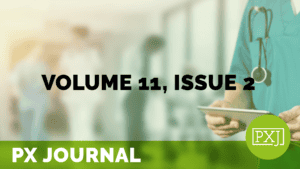The State of Patient Experience 2017: A Return to Purpose

The full research report from the Institute’s latest benchmarking study provides insights into trends in structure and practice, leadership and measurement and offers core considerations for organizations looking to lead in experience excellence. The largest research of its kind, the study engaged almost 1,700 respondents from 26 countries representing six continents sharing the challenges and opportunities they are facing and the steps they are taking to address the patient experience.
According to the research:
- Experience efforts are expanding and are now an integral part of the fabric of our healthcare efforts.
- Patient experience remains a top priority with a focus on employee engagement now seen as a central driver in experience efforts.
- Leadership and culture are now the significant motivators versus the historic focus on mandates and requirements, and there is a recognition of the impact that patient/family voice and caregiver engagement has on the work of healthcare.
- Patient experience itself continues to establish presence with the role of patient experience leaders, experience team size and the use of a formal definition on the rise.
- Patient experience is now being recognized as an integrated effort touching on much of what we do in healthcare and one that drives clear and measurable outcomes.
In acknowledging their commitment to the patient experience movement, this year’s study is made possible with the support of Philips, a global leader in health technology.
Related content
-
 Innovation & Technology
Innovation & TechnologyDiscover How Technology Can Add Value to Patient Experience
No real-time feedback? Lagging indicators? Cumbersome solutions? If these challenges sound similar to the ones you face in your hospital to learn about your patients’ experiences of care, this learning bite will introduce you to ways technology can help. Discover how using the right solution can streamline your patient data collection, more efficiently assess their
Learn more -
 Innovation & Technology | Patient Family & Community Engagement
Innovation & Technology | Patient Family & Community EngagementBuilding Trust in Healthcare: Insights from UAB Medicine’s Humanistic Care Study
PX MARKETPLACE – 2pm ET / 1pm CT / 12pm MT / 11am PT – Join Chris Brainard, Associate Vice President at UAB Medicine, and Amber Maraccini, VP of Healthcare Executive Advisory at Medallia, for a fireside chat on UAB’s innovative strategies to build trust in patient care. Explore how provider behaviors—like listening patiently and
Learn more -
 Innovation & Technology
Innovation & TechnologyPatient Experience and Virtual Reality: The Use of an MRI Exam Simulator
Magnetic resonance (MR) imaging is a safe diagnostic method of high accuracy detection and characterization of various pathological conditions. However, due to the very closed aspect of the apparatus, the high sound amplitude emitted and the need to remain motionless for a significant time, some patients experience discomfort and high levels of anxiety, compromising time
Learn more
